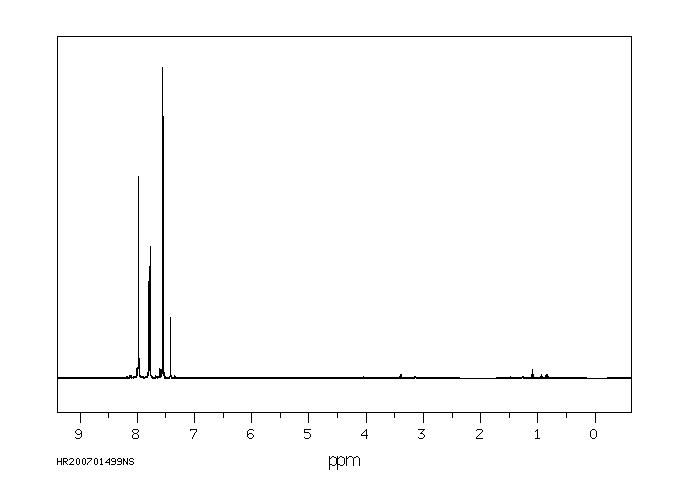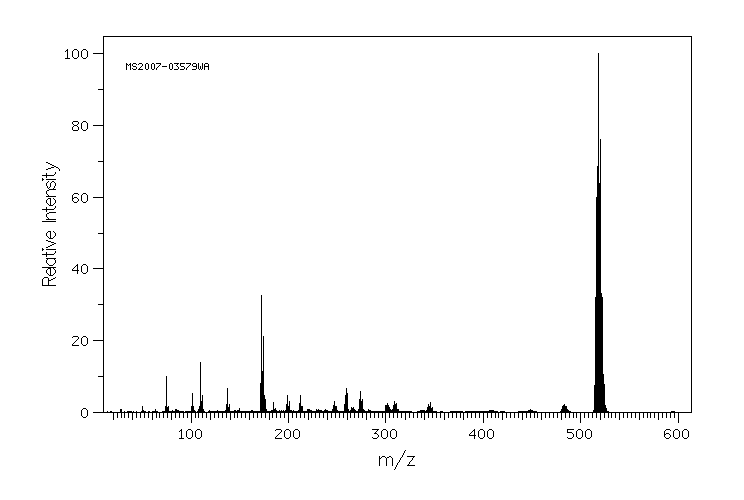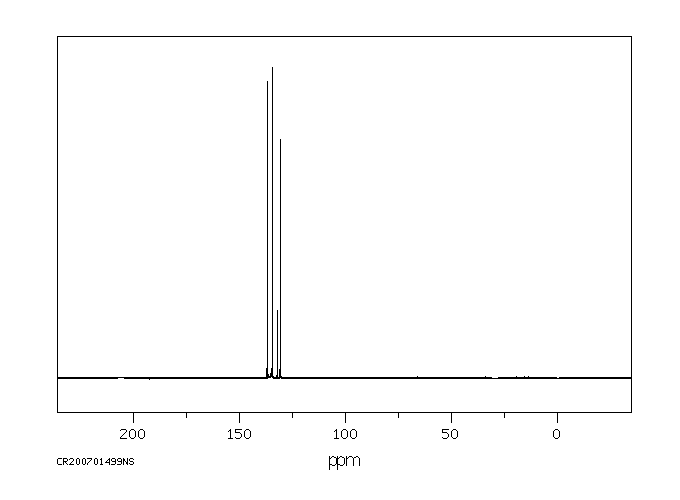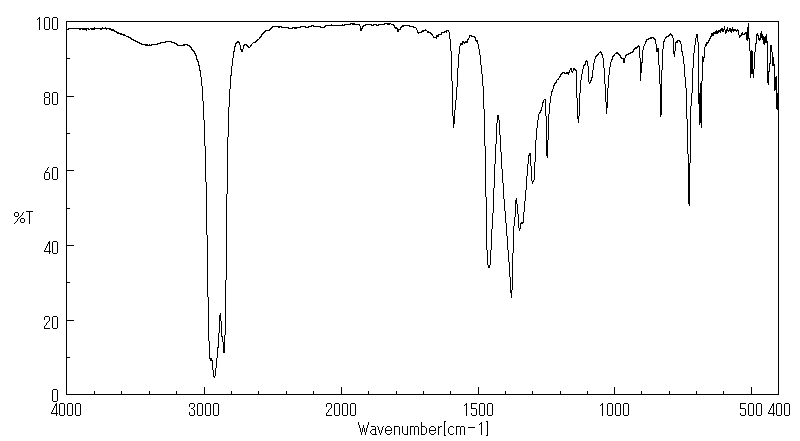2,4,6-三(3,4-二氯苯基)环硼氧烷 | 1133798-41-0
中文名称
2,4,6-三(3,4-二氯苯基)环硼氧烷
中文别名
——
英文名称
2,4,6-tris(3,4-dichlorophenyl)boroxine
英文别名
2,4,6-tri-(3,4-dichlorophenyl)boroxin;3,4-dichlorophenylboroxine;2,4,6-tris (3,4-dichlorophenyl)-1,3,5,2,4,6-trioxatriborinane;2,4,6-Tris(3,4-dichlorophenyl)boroxin;2,4,6-tris(3,4-dichlorophenyl)-1,3,5,2,4,6-trioxatriborinane
CAS
1133798-41-0
化学式
C18H9B3Cl6O3
mdl
——
分子量
518.419
InChiKey
ACMLOUSDQIZBAK-UHFFFAOYSA-N
BEILSTEIN
——
EINECS
——
-
物化性质
-
计算性质
-
ADMET
-
安全信息
-
SDS
-
制备方法与用途
-
上下游信息
-
文献信息
-
表征谱图
-
同类化合物
-
相关功能分类
-
相关结构分类
物化性质
-
溶解度:溶于甲醇
计算性质
-
辛醇/水分配系数(LogP):5.16
-
重原子数:30
-
可旋转键数:3
-
环数:4.0
-
sp3杂化的碳原子比例:0.0
-
拓扑面积:27.7
-
氢给体数:0
-
氢受体数:3
上下游信息
-
上游原料
中文名称 英文名称 CAS号 化学式 分子量 3,4-二氯苯硼酸 3,4-dichlophenylboronic acid 151169-75-4 C6H5BCl2O2 190.821
反应信息
-
作为反应物:描述:2,4,6-三(3,4-二氯苯基)环硼氧烷 、 2,6-二甲氧基苯甲酸 在 palladium(II) trifluoroacetate 、 silver carbonate 、 glyoxal bis(N-methyl-N-phenylhydrazone) 作用下, 以 二甲基亚砜 为溶剂, 反应 2.0h, 以14%的产率得到参考文献:名称:Palladium-catalyzed decarboxylative coupling of benzoic acid derivatives using hydrazone ligands摘要:Palladium-catalyzed decarboxylative coupling of benzoic acid derivatives with arylboroxins gave biaryls using a catalytic amount of Pd(TFA)(2)-hydrazone Id system with Ag2CO3 at 80 degrees C in good yields. We also found that decarboxylative coupling with aryl(trialkoxy)silanes gave biaryls using a Pd(TFA)(2)-hydrazone 1g system with AgF in good yields. 2014 Elsevier Ltd. All rights reserved.DOI:10.1016/j.tetlet.2014.04.017
-
作为产物:描述:参考文献:名称:多步钯(II)催化从炔丙醇可扩展合成恶唑酮类化合物:环磺酰胺和芳基硼氧烷的β-选择性氧化Heck偶联。摘要:规模的鲸鱼:标题的氧化性Heck偶联以异常的β选择性进行,生成了各种支链取代的恶唑酮(参见方案; Ts =对甲苯磺酰基)。用简单的钯催化剂和廉价的试剂从容易获得的起始原料进行三步合成可以在单个反应容器中进行或按比例放大以制备大量这些氨基酸前体。DOI:10.1002/anie.201307471
文献信息
-
Effect of Chiral Diene Ligands in Rhodium-Catalyzed Asymmetric Addition of Arylboronic Acids to α,β-Unsaturated Sulfonyl Compounds作者:Takahiro Nishimura、Yuka Takiguchi、Tamio HayashiDOI:10.1021/ja303109q日期:2012.6.6Asymmetric addition of arylboronic acids to α,β-unsaturated sulfonyl compounds proceeded in the presence of a rhodium catalyst coordinated with a chiral diene ligand to give high yields of the addition products with high enantioselectivity (96->99.5% ee). The diene ligand was proved to be essential for the formation of the addition products, while the use of a bisphosphine ligand mainly gave the cine-substitution
-
<b>Highly Enantioselective Ferrocenyl Palladacycle-Acetate Catalysed Arylation of Aldimines and Ketimines with Arylboroxines</b>作者:Carmen Schrapel、Wolfgang Frey、Delphine Garnier、René PetersDOI:10.1002/chem.201605244日期:2017.2.16importance. An attractive strategy is the arylation of imines with organoboron reagents. Chiral Rh complexes have reached a high level of productivity for this reaction type. In this article we describe that an electron rich PdII catalyst also performs well in the arylation of aldimines, comparable to the best Rh catalysts. The ferrocenyl palladacycle‐acetate catalyst allows for a broad substrate scope and
-
Electronic tuning of chiral diene ligands in iridium-catalyzed asymmetric 1,6-addition of arylboroxines to δ-aryl-α,β,γ,δ-unsaturated ketones作者:Takahiro Nishimura、Akira Noishiki、Tamio HayashiDOI:10.1039/c2cc16973h日期:——Asymmetric addition of arylboroxines to δ-aryl-α,β,γ,δ-unsaturated ketones proceeded in the presence of an iridium catalyst coordinated with a chiral diene ligand to give high yields of δ-diaryl ketones with very high enantioselectivity.
-
HETEROCYCLIC COMPOUND AND USE THEREOF申请人:KORI Masakuni公开号:US20120077799A1公开(公告)日:2012-03-29Provided is a compound represented by the formula (I): wherein each symbol is as defined in the specification, or a salt thereof, which has an AMPA (α-amino-3-hydroxy-5-methyl-4-isoxazolepropionic acid) receptor potentiating action. The compound of the present invention is useful as a prophylactic or therapeutic drug for depression, schizophrenia, Alzheimer's disease or attention deficit hyperactivity disorder (ADHD) and the like.
-
Heterocyclic compound and use thereof申请人:Takeda Pharmaceutical Company Limited公开号:US08778934B2公开(公告)日:2014-07-15Provided is a compound represented by the formula (I): wherein each symbol is as defined in the specification, or a salt thereof, which has an AMPA (α-amino-3-hydroxy-5-methyl-4-isoxazolepropionic acid) receptor potentiating action. The compound of the present invention is useful as a prophylactic or therapeutic drug for depression, schizophrenia, Alzheimer's disease or attention deficit hyperactivity disorder (ADHD) and the like.
表征谱图
-
氢谱1HNMR
-
质谱MS
-
碳谱13CNMR
-
红外IR
-
拉曼Raman
-
峰位数据
-
峰位匹配
-
表征信息
同类化合物
(βS)-β-氨基-4-(4-羟基苯氧基)-3,5-二碘苯甲丙醇
(S,S)-邻甲苯基-DIPAMP
(S)-(-)-7'-〔4(S)-(苄基)恶唑-2-基]-7-二(3,5-二-叔丁基苯基)膦基-2,2',3,3'-四氢-1,1-螺二氢茚
(S)-盐酸沙丁胺醇
(S)-3-(叔丁基)-4-(2,6-二甲氧基苯基)-2,3-二氢苯并[d][1,3]氧磷杂环戊二烯
(S)-2,2'-双[双(3,5-三氟甲基苯基)膦基]-4,4',6,6'-四甲氧基联苯
(S)-1-[3,5-双(三氟甲基)苯基]-3-[1-(二甲基氨基)-3-甲基丁烷-2-基]硫脲
(R)富马酸托特罗定
(R)-(-)-盐酸尼古地平
(R)-(-)-4,12-双(二苯基膦基)[2.2]对环芳烷(1,5环辛二烯)铑(I)四氟硼酸盐
(R)-(+)-7-双(3,5-二叔丁基苯基)膦基7''-[((6-甲基吡啶-2-基甲基)氨基]-2,2'',3,3''-四氢-1,1''-螺双茚满
(R)-(+)-7-双(3,5-二叔丁基苯基)膦基7''-[(4-叔丁基吡啶-2-基甲基)氨基]-2,2'',3,3''-四氢-1,1''-螺双茚满
(R)-(+)-7-双(3,5-二叔丁基苯基)膦基7''-[(3-甲基吡啶-2-基甲基)氨基]-2,2'',3,3''-四氢-1,1''-螺双茚满
(R)-(+)-4,7-双(3,5-二-叔丁基苯基)膦基-7“-[(吡啶-2-基甲基)氨基]-2,2”,3,3'-四氢1,1'-螺二茚满
(R)-3-(叔丁基)-4-(2,6-二苯氧基苯基)-2,3-二氢苯并[d][1,3]氧杂磷杂环戊烯
(R)-2-[((二苯基膦基)甲基]吡咯烷
(R)-1-[3,5-双(三氟甲基)苯基]-3-[1-(二甲基氨基)-3-甲基丁烷-2-基]硫脲
(N-(4-甲氧基苯基)-N-甲基-3-(1-哌啶基)丙-2-烯酰胺)
(5-溴-2-羟基苯基)-4-氯苯甲酮
(5-溴-2-氯苯基)(4-羟基苯基)甲酮
(5-氧代-3-苯基-2,5-二氢-1,2,3,4-oxatriazol-3-鎓)
(4S,5R)-4-甲基-5-苯基-1,2,3-氧代噻唑烷-2,2-二氧化物-3-羧酸叔丁酯
(4S,4''S)-2,2''-亚环戊基双[4,5-二氢-4-(苯甲基)恶唑]
(4-溴苯基)-[2-氟-4-[6-[甲基(丙-2-烯基)氨基]己氧基]苯基]甲酮
(4-丁氧基苯甲基)三苯基溴化磷
(3aR,8aR)-(-)-4,4,8,8-四(3,5-二甲基苯基)四氢-2,2-二甲基-6-苯基-1,3-二氧戊环[4,5-e]二恶唑磷
(3aR,6aS)-5-氧代六氢环戊基[c]吡咯-2(1H)-羧酸酯
(2Z)-3-[[(4-氯苯基)氨基]-2-氰基丙烯酸乙酯
(2S,3S,5S)-5-(叔丁氧基甲酰氨基)-2-(N-5-噻唑基-甲氧羰基)氨基-1,6-二苯基-3-羟基己烷
(2S,2''S,3S,3''S)-3,3''-二叔丁基-4,4''-双(2,6-二甲氧基苯基)-2,2'',3,3''-四氢-2,2''-联苯并[d][1,3]氧杂磷杂戊环
(2S)-(-)-2-{[[[[3,5-双(氟代甲基)苯基]氨基]硫代甲基]氨基}-N-(二苯基甲基)-N,3,3-三甲基丁酰胺
(2S)-2-[[[[[((1S,2S)-2-氨基环己基]氨基]硫代甲基]氨基]-N-(二苯甲基)-N,3,3-三甲基丁酰胺
(2S)-2-[[[[[[((1R,2R)-2-氨基环己基]氨基]硫代甲基]氨基]-N-(二苯甲基)-N,3,3-三甲基丁酰胺
(2-硝基苯基)磷酸三酰胺
(2,6-二氯苯基)乙酰氯
(2,3-二甲氧基-5-甲基苯基)硼酸
(1S,2S,3S,5S)-5-叠氮基-3-(苯基甲氧基)-2-[(苯基甲氧基)甲基]环戊醇
(1S,2S,3R,5R)-2-(苄氧基)甲基-6-氧杂双环[3.1.0]己-3-醇
(1-(4-氟苯基)环丙基)甲胺盐酸盐
(1-(3-溴苯基)环丁基)甲胺盐酸盐
(1-(2-氯苯基)环丁基)甲胺盐酸盐
(1-(2-氟苯基)环丙基)甲胺盐酸盐
(1-(2,6-二氟苯基)环丙基)甲胺盐酸盐
(-)-去甲基西布曲明
龙蒿油
龙胆酸钠
龙胆酸叔丁酯
龙胆酸
龙胆紫-d6
龙胆紫










